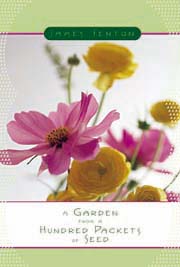|
March 31, 2005
Seed and Plant Exchangeby AMY STEWART IN JAMES FENTON'S BOOK A
GARDEN from a Hundred Packets of Seed, he not only explores
the possibilities of creating a garden on a small budget and
entirely from seed packets, he also advocates another kind of
gardenin Actually, he later admits that there is a certain wisdom to the shrubs-and-trees-as-backbone approach, but points out that many of us don't stay in one place long enough to fully experience the garden in its maturity, and besides, a garden built on packets of seeds is a perfect way to pass the first couple of years in a new garden, while you get to know the site, improve the soil and figure out the unique microclimate of your property. There's something to be said for Fenton's approach. I allow part of my garden to look perfectly boring all winter -- no bones, no structure, no shrubs, no trees -- because in May, it explodes into bloom and stays that way until October. I've planted all my favorite flowers there with just one rule in mind: When fall comes, there must be no large plant mass left to deal with. Everything gets chopped down to the ground where it sits, failing to inspire, never drawing praise, utterly lacking in curb appeal, until the following May. The nice part about planting a garden like this -- a flower garden that's all about the flowers -- is that the kinds of plants you'll choose are likely to be very affordable. Cosmos, daisy, bachelor button, yarrow, poppy -- they're all available as seeds or inexpensive six-packs, and they're so widely available that you can slip one into the grocery cart every time you walk past that little rack of plants outside the store without making a dent in the food budget. Over time, many of these plants reseed or allow themselves to be divided so that the territory you've devoted to them can expand. And if you decide later to make the garden more permanent and put in some of that "structure," it's no great loss to rip out some plants and move them or give them away. Which brings me, at last, to my point. For the seventh year in a row, there will be a seed and plant exchange at the Manila Community Center. This year the event takes place on Sunday, April 3, from noon to 4 p.m. (If you get there at 10, you can help out with a little dune restoration.) The rules are loose -- you don't necessarily have to bring a plant or seed to exchange in order to go home with something, although the spirit of the whole thing certainly suggests that you'd be better off looking around your yard for something that you can dig up and take with you. There will also be a raffle, and they'll be serving polenta with fresh greens. What's not to like? If you'd like to volunteer, or if you're part of a group that would like to have a table at the event, call Megan at 825-7125. Almost 300 people attended last year, so this is no small potatoes event. Stop by and check it out. Oh, and if you're inclined to start a garden from a hundred packets of seed yourself, remember: Improve the soil. Water. Thin seedlings like the heartless, brutal dictator you are. Wait. Enjoy. garden-related announcements and news to Amy Stewart. IN THE NEWS | COVER STORY | DIRT | THE HUM | STAGE DOOR | CALENDAR © Copyright 2005, North Coast Journal, Inc. |


 g
entirely. He points out that most garden design experts recommend
focusing first on structure, laying out the location of trees,
large shrubs, ponds and patios, and then filling in the gaps
with those little blooming things called flowers. The idea is
that a garden should have good bones, and that annual flowers,
as well as perennial flowers, that don't offer much in the way
of structure when they're not in bloom, should be seen as extras
in a show whose major stars are trees and shrubs. Fenton argues
otherwise, claiming that you should plant what you love and let
the flowers themselves shine without getting bogged down in ponderous
graph paper designs and hardscape.
g
entirely. He points out that most garden design experts recommend
focusing first on structure, laying out the location of trees,
large shrubs, ponds and patios, and then filling in the gaps
with those little blooming things called flowers. The idea is
that a garden should have good bones, and that annual flowers,
as well as perennial flowers, that don't offer much in the way
of structure when they're not in bloom, should be seen as extras
in a show whose major stars are trees and shrubs. Fenton argues
otherwise, claiming that you should plant what you love and let
the flowers themselves shine without getting bogged down in ponderous
graph paper designs and hardscape.